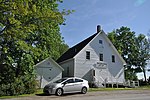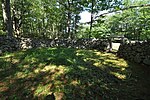Chimney Farm
Buildings and structures in Lincoln County, MaineFarms on the National Register of Historic Places in MaineHistoric districts on the National Register of Historic Places in MaineHomes of American writersNRHP infobox with nocat ... and 3 more
National Register of Historic Places in Lincoln County, MaineQueen Anne architecture in MaineUse mdy dates from August 2023

Chimney Farm is a historic farm property at 617 East Neck Road in Nobleboro, Maine. The heart of the farm is an early 19th-century farmhouse, which was from 1931 to their respective deaths home to the writers Henry Beston (1888–1968) and Elizabeth Coatsworth (1893–1986). Both were prominent regional award-winning writers, and the farm property played a prominent role on some of their writings. It was listed on the National Register of Historic Places in 2007.
Excerpt from the Wikipedia article Chimney Farm (License: CC BY-SA 3.0, Authors, Images).Chimney Farm
East Neck Road,
Geographical coordinates (GPS) Address Nearby Places Show on map
Geographical coordinates (GPS)
| Latitude | Longitude |
|---|---|
| N 44.115833333333 ° | E -69.475277777778 ° |
Address
East Neck Road 617
04555
Maine, United States
Open on Google Maps









